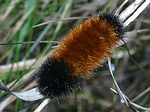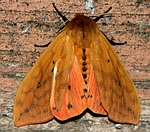Woolly Bears Forecast the Winter? There’s some history to say they can...
The summer has been so wet, it has hardly seemed like a season. Was there ever any sun? My garden burst open in the early days of spring and spent itself by mid-summer. Now it is behaving as though winter is near. I can’t help but wonder if this year it will be severe. Let me consult with a woolly bear.
While I am looking for one, I will tell you that there is a great deal of literature addressing the controversy over whether the woolly bear has the power of prognostication. There are those who scoff, as you might imagine, and there are those who are open to the possibility. There are still others who celebrate the woolly bear in annual rituals, much as the Romans prized their sybils.
The term “woolly bear” refers to the bristly black and rust caterpillar commonly seen toddling along the roadside or along the edges of a wood in September and October. It is boldly striped, like a rugby shirt, an observation made by Judy Sullivan in “A Woolly Bear Winter; Fern Glen Essays.” It curls into a tight little ball when you pick it up. It doesn’t bite or sting, but it may squirt a bit of green liquid into your hand. In the spring, it transforms into the Isabella Tiger moth.
It is commonly held that the woolly bear predicts the severity of the winter by wearing a wider rust stripe if the winter is to be mild. This phenomenon was studied from 1948 through 1956 by C.H. Curran, Curator of Insects at the Museum of Natural History in New York City. Every autumn he drove with his wife and friends up the Palisades Parkway to Bear Mountain for a vacation at the Bear Mountain Inn. He would collect a day’s worth of caterpillars, inspect them, and report his findings to the New York Herald Tribune.
He established that woolly bears have 13 colored segments divided into three stripes, each making up roughly a third of the caterpillar. He counted how many segments were black and how many were rust and averaged them over the number of caterpillars gathered that day. He found on average 5.3 to 5.6 segments were rust, making a wider stripe than expected in the years the following winters were mild. The woolly bears were correct 80% of the time.
There is, however, another way to read a woolly bear, er, worm, as they are referred to in the south. Since 1989, Banner Elk, North Carolina has held an annual woolly worm festival featuring a woolly worm race. The winner of the race is inspected by the retired mayor who then announces the forecast. His method correlates the front and back ends of the caterpillar with the beginning and end of winter, each intervening segment representing a week. The more black segments, the worse the winter, with the harshest weather occurring during the black segment weeks. The woolly worms are said to be correct 70% of the time.
Entymologists agree that there is a connection between woolly bear stripes and winter, but the stripes reflect the severity of the winter preceding. Woolly bears molt during the summer as they grow and with each molt, they replace a black segment with a rust one. Caterpillars with narrow bands are younger and not so well fed as the ones with wider stripes, suggesting they got a later start in the spring. Judy Sullivan calls them short term winter archivists. Even so, could not the narrow stripe also reflect the onset of an early autumn, as we seem to be having now? The final word is not in.
I haven’t found a woolly bear all this time you have been reading. You will have to observe your own Palisadian woolly bears when they are ready to start their search for winter quarters.



